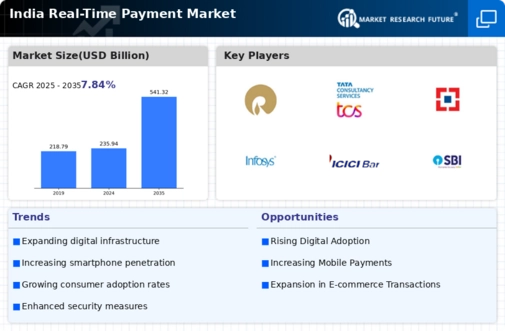E-commerce Growth
The rapid expansion of the e-commerce sector in India significantly influences the real time-payment market. As of 2025, the e-commerce industry is projected to reach a valuation of approximately $200 billion, with a substantial portion of transactions being conducted online. This growth is largely driven by the increasing number of internet users and the rising preference for online shopping. Real time payments facilitate immediate transactions, which are essential for e-commerce platforms to enhance customer satisfaction and reduce cart abandonment rates. Moreover, the integration of real time payment solutions into e-commerce platforms allows for smoother checkout processes, thereby encouraging more consumers to engage in online shopping. This trend indicates a strong correlation between e-commerce growth and the expansion of the real time-payment market.
Financial Inclusion Initiatives
Financial inclusion initiatives in India are significantly impacting the real time-payment market. The government has launched various programs aimed at bringing unbanked populations into the financial system, thereby increasing the user base for digital payment solutions. As of 2025, it is estimated that over 300 million individuals have gained access to banking services through these initiatives, many of whom are now utilizing real time payment methods. This shift not only enhances the overall transaction volume but also promotes economic growth by enabling more individuals to participate in the digital economy. The emphasis on financial literacy and accessibility is likely to drive further adoption of real time payment solutions, as more consumers recognize the benefits of instant transactions. Consequently, this trend suggests a promising future for the real time-payment market in India.
Increased Smartphone Penetration
The proliferation of smartphones in India has been a pivotal driver for the real time-payment market. As of 2025, smartphone penetration in India is estimated to exceed 80%, facilitating easier access to digital payment platforms. This surge in smartphone usage enables consumers to engage in real time transactions seamlessly, thereby enhancing the overall user experience. The convenience of mobile applications allows users to make payments instantly, which is particularly appealing in a fast-paced economy. Furthermore, the integration of biometric authentication and secure payment gateways in mobile devices has bolstered consumer confidence in digital transactions. Consequently, this trend is likely to continue propelling the growth of the real time-payment market, as more individuals opt for mobile solutions over traditional banking methods.
Regulatory Support and Framework
The regulatory environment in India plays a significant role in shaping the real time-payment market. The Reserve Bank of India (RBI) has implemented various policies aimed at promoting digital payments and enhancing financial inclusion. Initiatives such as the National Payments Corporation of India (NPCI) and the Unified Payments Interface (UPI) have established a robust framework for real time transactions. As of 2025, the RBI's focus on creating a secure and efficient payment ecosystem has led to increased trust among consumers and businesses alike. This regulatory support not only encourages innovation within the financial technology sector but also ensures that the real time-payment market remains competitive and accessible. The ongoing collaboration between regulatory bodies and payment service providers is likely to further strengthen the market's growth trajectory.
Rising Demand for Instant Transactions
The growing demand for instant transactions among consumers is a crucial driver for the real time-payment market. In an increasingly digital economy, consumers expect immediate access to their funds and swift transaction processing. This expectation is reflected in the rising adoption of real time payment systems, which offer instantaneous fund transfers without delays. As of 2025, it is estimated that over 60% of consumers prefer using real time payment methods for their transactions, indicating a shift in consumer behavior towards immediacy. Financial institutions and payment service providers are responding to this demand by enhancing their infrastructure to support real time payments, thereby fostering a competitive landscape. This trend suggests that the real time-payment market will continue to thrive as consumer preferences evolve towards faster and more efficient payment solutions.

















Leave a Comment